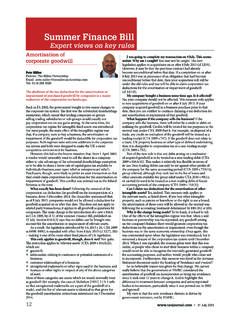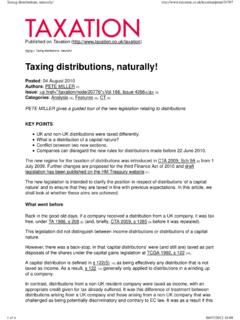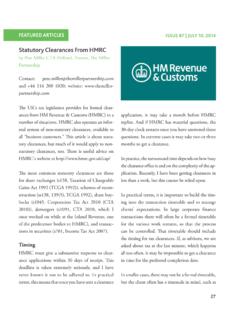Transcription of Demerger dilemma - themillerpartnership.com
1 Published on taxation ( )Home > Demerger dilemma26 February 2014 Demerger dilemmaTwo shareholders own eight properties through an investment company. They wish to go theirown way and would like to achieve this by forming two separate companies, each owning fourpropertiesA property investment company owns eight properties. The two directors, who are 50:50shareholders, each want to transfer four properties into their own 100%-owned is purely for commercial reasons; they want to go in different directions. The marketvalue of each set of four properties is broadly similar (about 3m) and my question is how dowe best effect this Demerger ?Presumably, a statutory Demerger under CTA 2010, Part 23 Ch 5 (TA 1988, s 213 as was) isout of the question because the property business is not a trade.
2 Also, a liquidation demergerwould seem to be ruled out because there are outstanding mortgages on these propertiesand the bank would not want the transferor company to be leaves us with a capital reduction Demerger . If we follow that path, am I correct inassuming that the following steps would need to be put in place to ensure no corporation taxis paid at the corporate level and no capital gains tax at the shareholder level?First, rearrange the share capital in the company into two separate classes, A and , insert a TopCo above the existing company under a share-for-share exchange (asthe market value of the properties is considerably higher than the share capital of the existingcompany).Third, transfer the B portfolio of properties earmarked for the B shareholder to , set up NewCo with shares issued to the B shareholder and transfer the B portfoliofrom TopCo to New , how can we avoid charges under TCGA 1992, s 179 because some of the eightproperties were transferred from other related companies?
3 In addition, assuming the abovesteps work from a corporation tax and capital gains tax standpoint, what about stamp dutyland tax; would the planning need to be tweaked to mitigate this charge?Query 18,340 Top KnotReply from Pete Miller, Miller PartnershipDemerger of 401/05/2014 15:47 Top Knot is correct in stating that a statutory Demerger under CTA 2010, Part 23 Ch 5 doesnot work with property investment companies. As readers will be aware, this route is onlyavailable for the separation of trading , the liquidation reconstruction route using Insolvency Act 1986, s 110, can workbut, as Top Knot points out, it is usually the banks that stand in the way of said, I think even the reduction of capital route would require the bank to accept thetransfer of some of the mortgages, but the bigger problem with the liquidation route is stampduty land tax (SDLT).
4 In a typical liquidation reconstruction, a new company (TopCo) is placed above the existingcompany and, in this case, the B portfolio would be transferred to it. TopCo is then liquidated,with the original company being transferred indirectly to shareholder A and the B portfoliodistributed indirectly to shareholder this is a distribution in a winding-up, to which FA 2003, s 54 would prima facie apply,it is HMRC s view that the issue of shares by the transferee company in the reconstructionstep is consideration , so that there would be an SDLT charge in respect of the B agree with Top Knot s suggested first three steps for a Demerger by reduction of , transferring the B portfolio from TopCo to NewCo will create an SDLT charge,exactly as described for a liquidation , I suggest that the fourth step is the setting up of NewCo by shareholder A, thereduction of capital by TopCo by cancelling the A shares.
5 And the transfer of the originalcompany, now holding only the A portfolio, to NewCo in return for the issue of shares toshareholder this way, there should be no SDLT charge, although a certain amount of care is required tomake sure one does not arise on a potential change of control of TopCo when the A sharesare cancelled (FA 2003, Sch 7 para 4ZA).Thus far, I am entirely comfortable, and I have carried out a number of these transactions,complete with HMRC pre-transaction clearances under TCGA 1992, s 138 and s 139(5) andITA 2007, s the basis of the information given, I do not think a de-grouping charge under TCGA 1992,s 179 arises. Although Top Knot says that some of the properties were transferred fromrelated companies, he does not suggest that this was a transfer from group companies, andthe charge under s 179 only arises where there was previously an intra-group there is a genuine degrouping problem here, the choice might be between the degroupingcharge and an SDLT charge in respect of the B portfolio.
6 It is hard to see another solution(other than waiting until the six-year period has elapsed) which would not be seen by HMRCas being tax avoidance, thereby jeopardising the possibility of a pre-transaction from Tax Time LordSplitting property business interests between different shareholders through a companydemerger is often difficult and, in most cases, there will often be a stamp duty land tax (SDLT)or stamp duty Top Knot concludes, a statutory Demerger under CTA 2010, Part 3 Ch 5 cannot be used toDemerger of 401/05/2014 15:47demerge a property investment business. However, it should normally be possible to use aliquidation Demerger , by putting a TopCo over the existing company by means of a shareexchange. TopCo would then become the liquidation vehicle under the Insolvency Act, s 110arrangement.
7 Banks will generally agree to a transfer of the relevant debt providing this doesnot prejudice their , I will concentrate on Top Knot s preferred route of a capital-reduction structureddemerger, since this does provide some clear benefits (for example, it is only necessary todistribute half of the property investment portfolio).As currently structured, Top Knot s Demerger plan is likely to involve a substantial SDLT cost(which is likely to make it a non-starter). Based on the facts provided, the transfer of the Bportfolio of properties from TopCo to New Co is likely to attract an SDLT charge at the fullrelevant rate (step 4).This is because the SDLT acquisition relief in FA 2003, Sch 7 para 8 (which normally reducesthe SDLT rate to 1/2% on business partitions) is blocked where the relevant properties areheld as investments (see Sch 7 para 5A).
8 Assuming we are dealing with commercialproperties, in a straighforward case, the estimated SDLT cost would be around 120,000 (ie 3m at 4%).My normal approach to the partition of property investment businesses is to avoid orminimise the transfer of the properties themselves. Thus, for example, Top Knot mightconsider arranging an in-specie distribution of the properties that are going to be retained (iethe A portfolio as opposed to the B portfolio) to TopCo. This should be free of SDLT unlessTopCo assumes any property can then distribute the shares in the existing property investment company(PropInvCo) by way of a capital reduction to Newco in consideration of a fresh issue of sharesto the A shareholder. This should only give rise to a stamp duty cost of 1/2% on the no reliance was placed on the SDLT group relief rules, SDLT degrouping chargesmight be avoided on the properties transferred to TopCo, subject to the impact of any priorgroup transfers (see anti-avoidance rule in FA 2003, s 54(4)).
9 If the capital reduction is properly implemented there should be no income tax distributioncharge for the A gains reconstruction relief under TCGA 1992, s 139 should also be available forthe transfer of the shares in PropInvCo. HMRC have confirmed that any corporate gainsdegrouping charge under TCGA 1992, s 179 (calculated under the revised FA 2011degrouping regime) would be covered by the no gain/no loss consideration 139 relief can only be secured if HMRC are satisfied that the transactions are drivenby commercial requirements (as opposed to mainly tax avoidance ones). It is thereforeessential that HMRC clearance be obtained in are potential corporate gains degrouping issues for TopCo as well since it also leavesthe capital gains group when PropInvCo is transferred to Newco.
10 However, they should beexempted under HMRC s two-company group practice see HMRC s Capital Gains Manualat CG45410 (special rule 5).It is difficult to provide a comprehensive analysis in the space available, but Top Knot shouldbe prepared to take specialist of 401/05/2014 15:47 Categories: Capital Gains [1]Corporation Tax [2]Investments [3]Land [4]Tax Topic Tags: Forum & Feedback [5]Closer stamp duty land tax and liquidationsThe replies refer to the stamp duty land tax implications of a liquidation. HMRC s CapitalGains Manual at CG45410 looks at the the degrouping charge: when a charge is triggered,special rules . Nine special rules are mentioned, but special rule 5 is referred to in the states: Special rule 5: the two company group practice.




